Physical Address
304 North Cardinal St.
Dorchester Center, MA 02124
Physical Address
304 North Cardinal St.
Dorchester Center, MA 02124
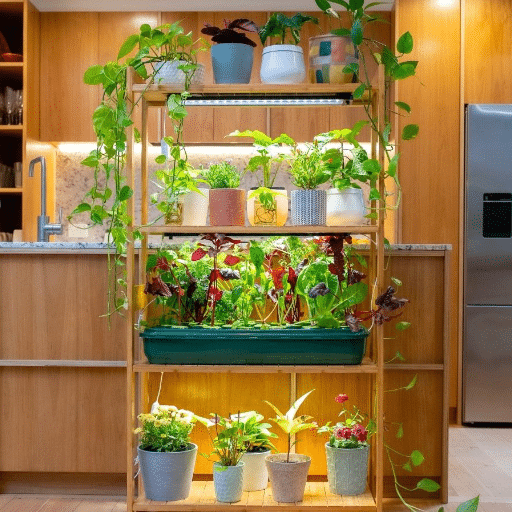
Starting an indoor garden is more than just a hobby—it is a rewarding opportunity to beautify a living space, cleanse air, and grow fresh herbs, veggies, or decorative plants all year round. Whether you are an experienced gardener or just starting out, indoor gardening gives a controlled environment that opens up benefits sometimes not found in outdoor gardens. This guide covers the basic knowledge needed for you to start your own thriving indoor garden-from choosing the right plants, understanding their needs, selecting the right containers, lighting, and care techniques. A little know-how will go a long way, even in small spaces, turning areas into lush vibrant oases. Read on to learn how you may grow a sustainable and rewarding garden right in the comfort of your home.
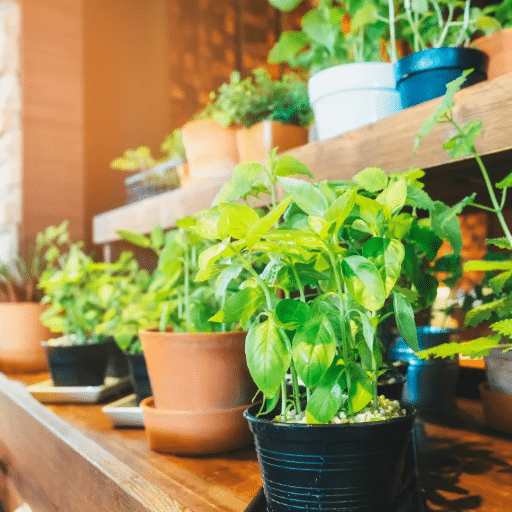
Plants: First and foremost, to begin an indoor garden, the plants must be chosen. Indoor plants like pothos, snake plants, peace lilies, basil, or mint are good choices. Evaluating light availability is essential before deciding on flowers, as some prefer bright, indirect light and others may do well in somewhat dimmed settings. Should one feel that space is an issue with respect to the size of their plants, they should consider something that will suit their indoor conditions. Beginners may want to pick hardy, low-maintenance plants.
Consider lights when setting up your indoor garden. Find spots with enough natural light, such as windows, or rooms with sufficient sunlight, and use grow lights if needed for less illuminated spaces. Make sure the area is ventilated enough to prevent humidity problems and easy to access for maintenance, like watering or pruning. Also, take into consideration the dimensions and shape of the area so that there is enough room for the plants to flourish without any crowdedness. The surface or shelving you pick should be firm enough for holding the plants, but avoid high-traffic areas where they can be disturbed.
A reasonable set of requirements will need to be assembled to start the indoor garden, paying special attention to the easiest condition in which to grow plants. First, select containers with drainage so that water cannot remain in the container to cause root rot. Then obtain potting soil that is of good quality and suited to the requirements of your plants. Lighting cannot be ignored at this point. If you do not have adequate natural light in your space, go for some LED grow lights. Then a watering can with a thin spout will allow for gentle watering, and a spray bottle will keep humidity up when needed. A small trowel, pruning shears, and gloves will also come in handy for planting. Finally, consider buying fertilizers for your plants so they can get those nutrients. Having these supplies will form the basis for an indoor garden with healthy plants.
A good drainage system, along with suitable soil selection, assures healthy indoor plants. Drainage stops excess water from pooling within the pot, thus preventing root rot and waterlogging conditions affecting the plants adversely. Potted plants must be kept in pots with drainage holes; adding a layer of small stones or gravel at the bottom is an option for extra drainage. Selection of potting soil should be made with the plant’s requirements in mind; for example, cacti and succulents prefer fast-draining soil mixtures that contain coarse grit, sand, or perlite, whereas common houseplants will do best in nutrient-rich soils that can retain moisture. On no occasion should one consider using garden soil in potted planting, for it tends to compact into the pots and detracts from proper water flow. Knowing these things will help you establish a sturdier environment conducive to root development and general plant health.
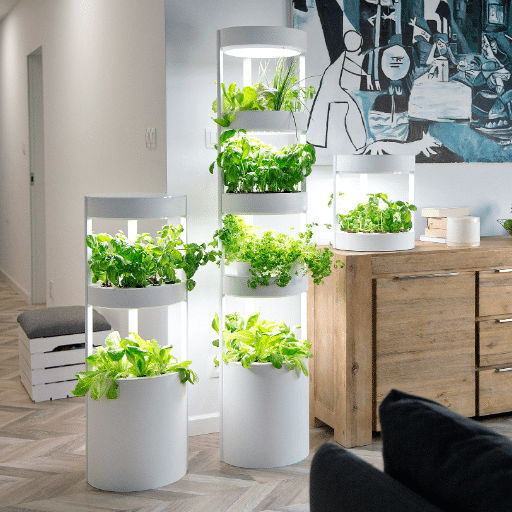
Your indoor gardening plants must take some factors into consideration such as light availability, temperature, and the level of humidity in your space. Choose plants suited for the low-light environment, such as pothos and snake plants, while bright places are for the likes of fiddle leaf figs or succulents. Assess the time you can commit to taking care of the plants-whether you can afford low-maintenance plants such as ZZ plants or peace lilies or not. Always ensure if you have pets and small children that your plants are toxic-free by consulting valid references like the ASPCA. Choosing plants suitable to one´s environment ensures they mature well and grow long life.
When choosing herbs for an indoor garden, give preference to those that flourish in small spatial confines and keep well in a controlled environment. Herbs such as basil, mint, parsley, chives, and thyme are all good choices due to their versatility and relative ease of care. They prefer well-draining soil, regular watering, and indirect sun exposure for at least 4 to 6 hours daily. In the case of insufficient sunlight in your house, the amount might be supplemented with grow lights. Also, take into consideration the growth habits of each herb: some, like mint, tend to spread rather quickly, so consider keeping these in their own containers to prevent competition. Pruning them keeps them growing while preventing stem elongation, and your hands will remain full with fresh herbs to use in cooking.
Growing vegetables indoors is possible and highly rewarding provided the proper environment is met. Leafy greens such as lettuce, spinach, and kale are ideal for growing indoors as they need minimal space and finish their growth in a short period under artificial lights. You may put in your herb garden alongside the vegetables, choosing basil, chives, and parsley. Also, small-fruited vegetables like cherry tomatoes, chili peppers, and dwarf cucumbers can be grown indoors with a provided supply of sunlight or grow lights, good aerated soil, and regular watering. Adequate drainage should be ensured to avert root rot, while a balanced liquid fertilizer should be given regularly for good and healthy growth. If these points are well taken care of, then you will have a flourishing and efficient vegetable garden indoors.
Several indoor plants thrive in low lighting, making them suitable for areas with not much natural sunlight. Think Snake Plant or Sansevieria- tolerate the least of light and irregular watering. ZZ plant, too, is hardy with its shiny foliage. Pothos is also a good choice with trailing vines, while Peace Lily or Spathiphyllum blooms with poetic white flowers even in dim lighting. Then Cast Iron Plants and Spider Plants are sturdy and require less upkeep. It is good to water them accordingly, occasionally feed, and rotate them to give each side equal light exposure.
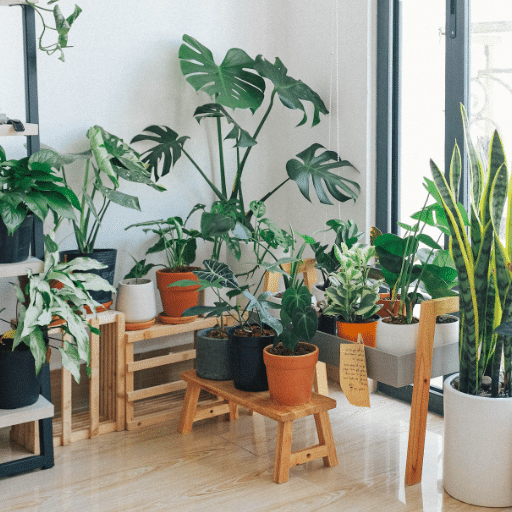
If propagation is your choice of propagation for multiplying indoor flowering plants, you do not have to pay for new ones. The common ways of propagation are:
Stem Cuttings: Plants like Pothos or Philodendrons take stem cuttings that go into water or soil until they root.
Division: For Peace Lilies, a delicate act of breaking apart a root clump and repotting it in some fresh soil would be best.
Leaf Cuttings: For the succulents, any leaf should do, planted in the soil, to continue the journey of becoming a proper “new plant.”
Make sure proper light, moisture, and temperature conditions prevail during propagation.
Watering is critical to maintaining the health and life of indoor plants. Differences in frequency and amount of water need are possessed by plants. Overly wet plants eventually become prone to root rot disease, while excessively dry ones go ahead and die. Adequate watering is ensured by observing the moisture content of the soil; for most houseplants, the top inch of soil should dry a bit between waterings. Season and humidity levels in your home influence watering schedules. Generally, indoor plants require less watering during winter months, while faster-growing plants in brighter environments may require more frequent applications. Always use drained pots and quality potting soil so that healthy moisture levels can be maintained.
Hydroponic setups are considered a highly efficient approach to indoor gardening since they eradicate the use of soils, instead of providing nourishment to root systems via a water-based nutrient approach. These systems are classified into various types; some include nutrient film technique (NFT), deep water culture (DWC), aeroponics, and drip systems. Each system presents advantages that depend on the crops grown or the experiment layout on offer. NFT systems provide a thin film of nutrient solution that is continually flowing over the roots, which suits lightweight plants, such as leafy greens. DWC has the plant roots immersed in an aerated solution, making it best for large plants because of the simplicity of its design and delivery of nutrients. In aeroponics, roots are suspended in air, in which nutrients are finely misted, allowing seedlings in the growth rate-limiting environment to proceed rapidly. Drip systems deliver compounds of nutrient solution in controlled amounts to individual plants, allowing great flexibility when mixing operations with different crop types. The choice of a hydroponic set-up or system will depend on such matters as the type of plant, what space limitations exist, and whether the set-up is going to be scalable, all of which will help to make it most efficiently run and yield highest possible.
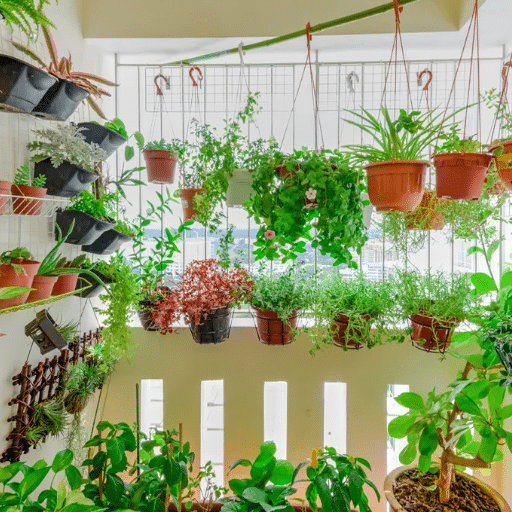
Vertical wall gardens provide an efficient way to grow indoor plants by using the vertical surface of a wall. It can involve mounting various planters, pocket panels, or hydroponics with vents to allow a fantastic variety of greenery from herbs to ornamental plants to flourish indoors. Especially good for small spaces, they would refresh the air and ambience.
An indoor garden can be established by means of hanging planters. These planters are meant to be suspended from ceiling or walls, where they will hold trailing plants such as pothos, ivy, or ferns, maximizing space; they will also nurture an ever-so-dramatic funk-factor. Without using too much floor space, they can be arranged in many configurations to catch one’s attention.
Watering systems are very easy to maintain and so great for those on-the-go. They work with a reservoir, so the water is provided constantly to the plants, thus needing less frequent watering. Such systems are ideal for growing low-maintenance varieties like succulents or herbs indoors.
While designing the kitchen garden indoors, a few factors should be accounted for to give great growth conditions and make maintenance easier. First is to determine the space and light conditions, since most edible plants generally want good light, either natural or artificial. Then the choice of the gardening system shall depend upon your space and maintenance. Hydroponic systems, vertical planters, or pot-based systems would be the options. The next factor to consider is ventilation, picking plants suitable for the indoor environment, e.g., herbs, leafy greens, or dwarf vegetables. And now will come the integration of some automated items, like timers for the lighting, self-watering systems, etc., to reduce the cultivation effort and have an efficient and productive indoor kitchen garden.
In essence, vertical gardening is an innovative and practical approach to gardening in limited space. Areas may be utilized maximally with a functional appeal by way of vertical plans like wall planters, trellises, or modular systems. Select lightweight materials and designs that can hold on structurally through ease of installation. Plants for vertical gardening could be climbers such as peas or beans, cascading herbs such as thyme or oregano, and leafy greens that grow well in small plant arrangements. In addition, installation of drip irrigation, vertical grow lights, and other environmental control supports will reduce maintenance involved in supporting plant growth in constrained environments.
Artificial light is important in any environment where there’s insufficient natural light to allow photosynthesis and keep plant growth healthy. In terms of optimizing growth, several factors must be considered. Choosing the correct type of light, be it LED, fluorescent, or high-intensity discharge (HID), is all based on the stage of growth under consideration as all types emit different spectra. LED full-spectrum lights tend to be preferred for being more energy-efficient and closer to natural sunlight. A good consideration is to place artificial lights at the right distance so that light is evenly distributed among the plants and does not heat up or cause photodamage to them. Poor photoperiod choice is also destructive; a suitable set light schedule in alignment with the photoperiod requirements of the plants is necessary. So far, this covers the technological setup. But with the addition of features such as timers and adjustability, it will make life much easier and highly efficient for the grower.
Sher She Grows – Indoor Gardening: Everything You Need to Know: This source explains the basics of indoor gardening, including methods and considerations for starting an indoor garden.
Architectural Digest – A Beginner’s Guide to Indoor Gardening Like a Pro: A comprehensive guide for beginners, covering techniques and tools for successful indoor gardening.
Plantaform – The Benefits of Growing with an Indoor Garden: Highlights the health, environmental, and financial benefits of indoor gardening.
Adequate drainage is essential in indoor gardening to prevent the water from sitting on the roots and causing root rot. House pots are franchised with holes at the bottom to facilitate drainage. A layer of little stones or gravel can be added to the pot before the potting soil goes in; this aids the water to flow and prevents the soil from becoming too compact. Observing the moisture level of the soil regularly would help avoid overwatering. If the soil is constantly soggy under your watchful eye, it may be the time to improve the drain.
The question that arises is whether plants thrive in the interiors. And if yes, which plants? Succulents, ferns, and flowering plants are some examples of those plants. Depending on how much light they receive and the environmental conditions you can provide, the choice of plants changes accordingly. Some of the easiest houseplants to grow with a fair amount of neglect are spider plants, pothos, and snake plants. Given suitable care and attention, fruiting plants and herbs also respond well. A little study in specific indoor gardening methods will ensure a colorful indoor garden with a variety of plants.
Growing plants with hydroponic systems indoor can greatly benefit with hydroponics. Plants are grown without soil, instead, they are given nutrients through a water-based solution. That way, water and nutrients can be controlled more rigorously, and hence faster and more robust plants grow. Hydroponic systems may come in various sizes and configurations; they include the nutrient film technique and deep water culture. pH and nutrient levels have to be checked frequently. Given good setup, plants are grown in hydroponics all year round, even during winters.
Beginning with easier crops such as herbs and leafy greens, is appropriate for beginners to start their own food production at home. Build a small herb garden on your windowsill, or purchase a smart garden kit, which gives a controlled environment for plants. Then, ensure that proper lighting is given from the sunlight or grow lights so that the plants grow with energy from light via photosynthesis. Follow simple practices, like checking the moisture in the soil and giving good potting soil. More experienced ones may go on to more challenging plants and DIY to diversify their indoor gardening experience.
This article is ready to be copied and pasted directly into your WordPress editor for immediate publication.